Pump Handbook by Igor J. Karassik, Joseph P. Messina, Paul Cooper, Charles C. Heald - 3rd edition
Подождите немного. Документ загружается.

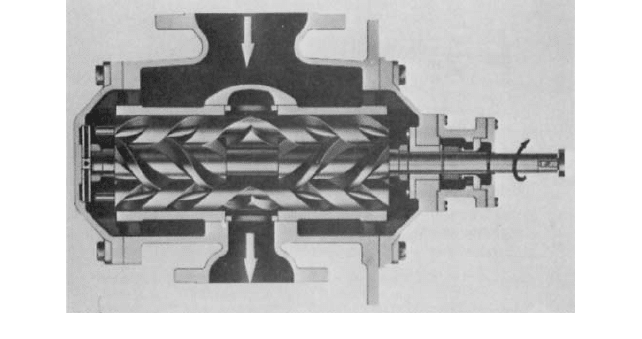
3.104 CHAPTER THREE
FIGURE 8 Double-end pump. Flow path provides axial balance. (Imo Pump)
Timed screw pumps require separate timing gears between the rotors and separate
support bearings at each end to absorb the reaction forces and maintain the proper clear-
ances. Untimed screw pumps do not require gears or external bearings and thus are con-
siderably simpler in design.
CONSTRUCTION _____________________________________________________
Basic Types
As indicated in the introduction, three major types of screw pumps exist:
• Single-rotor
• Multiple-rotor timed
• Multiple-rotor untimed
The second and third types are available in two basic arrangements, single-end and
double-end. The double-end construction (see Figure 8) is probably the best-known ver-
sion, as it has been by far the most widely used for many years because of its relative sim-
plicity and compactness of design.
Double-End Screw Pumps The double-end arrangement is basically two opposed, sin-
gle-end pumps or pump elements of the same size with a common driving rotor that has
an opposed, double-helix design with one casing. As can be seen from Figure 8, the fluid
enters a common inlet with a split flow going to the outboard ends of the two pumping
elements and is discharged from the middle or center of the pump elements. The two
pump elements are, in effect, pumps connected in parallel. The design can also be pro-
vided with a reversed flow for low-pressure applications. In either of these arrangements,
all axial loads on the rotors are balanced, as the pressure gradients in each end are equal
and opposite.
The double-end screw pump construction is usually limited to low- and medium-
pressure applications, with 400 lb/in
2
(28 bar) being a good practical limit to be used for
planning purposes. However, with special design features, applications up to 1400 lb/in
2
(97 bar) can be handled. Double-end pumps are generally employed where large flows are
required or where very viscous liquids are handled.
Single-End Screw Pumps All three types of screw pumps are offered in the single-end
construction. As pressure requirements in many applications have been raised, the sin-
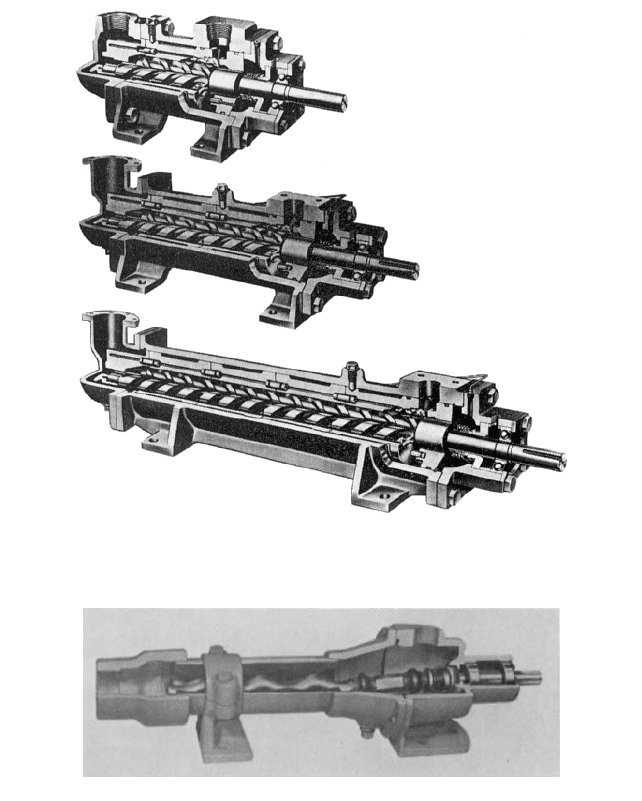
3.7 SCREW PUMPS 3.105
FIGURE 9 Increasing pump pressure capability by modular design (Imo Pump).
FIGURE 10 Single-rotor pump. (Robbins-Meyers)
gle-end design has come into much wider use because it provides the only practical means
for obtaining the greatest number of moving seals necessary for high-pressure capabili-
ties. The main penalties of the single-end pump are the requirement and complexity of
balancing the axial loads.
The single-end construction is most often employed for handling low-viscosity fluids at
medium-to-high pressures or hydraulic fluids at very high pressures. The single-end
design for high pressures is developed by literally stacking a number of medium-pressure,
single-end pumping elements in a series within one pump casing (see Figure 9).The single-
end construction also offers the best design arrangement for quantity manufacturing.
Special mention must be made of the single-end, single-rotor design (see Figure 10).
The pump elements of this design consist of only a stator and one rotor. The stator has a
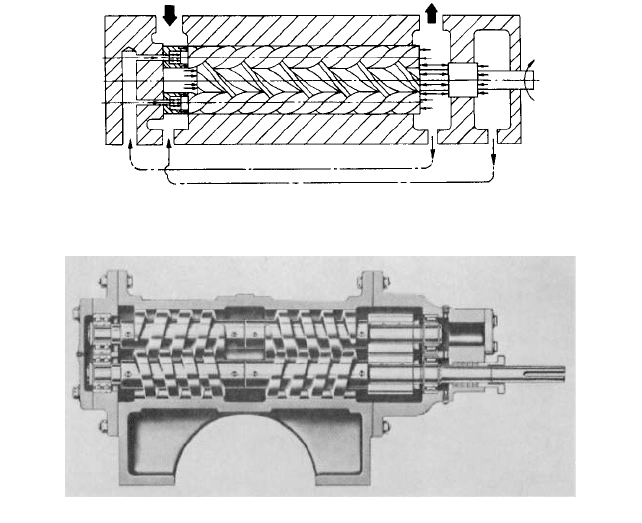
3.106 CHAPTER THREE
FIGURE 12 Double-end internal gear design. (Flowserve Corporation)
FIGURE 11 Axial balancing of power and idler rotors.
double-helix internal thread and is constructed of hard chrome stainless or tool steel mate-
rial. One version of this design uses internally developed pressure in the pump to com-
press the elastomeric stator on the rotor, thus maintaining minimum running clearances.
In most single-end designs, special axial balancing arrangements must be used for
each of the rotors, and, in this respect, the design is more complicated than the double-end
construction. For smaller pumps, strictly mechanical thrust bearings can be used for dif-
ferential pressures up to 150 lb/in
2
(10.3 bar), while hydraulic balance arrangements are
used for higher pressures. For large pumps, hydraulic balance becomes essential at pres-
sures above 50 lb/in
2
(3.5 bar).
Hydraulic balance is provided through the balance piston (see Figure 11) mounted on
the rotors between the outlet and seal or bearing chambers, which are at inlet pressure.
This piston is exposed to discharge pressure in the outlet chamber and is equal in area to
the exposed area of the driven rotor threads; thus, the hydraulic forces on the rotor are
canceled out.
Timed Design Timed screw pumps having timing gears and rotor support bearings are
furnished in two general arrangements: internal and external. The internal version has
both the gears and the bearings located in the pumping chamber and the design is rela-
tively simple and compact (see Figure 12). This version is generally restricted to the han-
dling of clean lubricating fluids, which serve as the only lubrication for the timing gears
and bearings.
The external timing arrangement is the most popular and is extensively used. It has
both the timing gears and the rotor support bearings located outside the pumping cham-
ber (see Figure 13). This type can handle a complete range of fluids, both lubricating and
non-lubricating, and, with proper materials, has good abrasion resistance. The timing
gears and bearings are oil-bath-lubricated from an external source. This arrangement
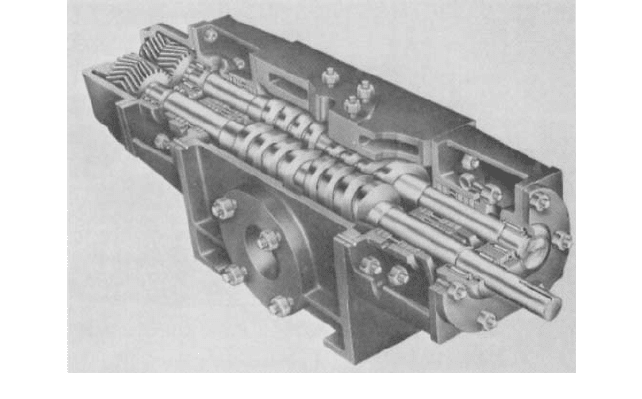
3.7 SCREW PUMPS 3.107
FIGURE 13 Double-end external gear design. (Warren)
requires the use of four stuffing boxes or mechanical seals, as opposed to the internal type,
which employs only one shaft seal.
The main advantage of the timed screw pump is that the timing gears transmit power
to the rotors with no contact between the screw threads, thus promoting long pump life.
The gears and rotors are timed at the factory to maintain the proper clearance between
the screws. With certain designs and loading characteristics, the bearings at each end of
the rotating elements can support the rotors so that they do not come in contact with the
housing; hence, no liner is required. One set of these bearings also positions and supports
the timing gears. Under more heavily loaded conditions, the body bores act as sleeve bear-
ings and provide additional support for the rotors.
The timing gears can be either spur or helical, herringbone, hardened-steel gears with
tooth profiles designed for efficient, quiet, positive drive of the rotors. Antifriction radial
bearings are usually of the heavy-duty roller type, while the thrust bearings, which posi-
tion the rotors axially, are either double-row, ball-thrust or spherical-roller types.
The housing can be supplied in a variety of materials, including cast iron, ductile iron,
cast steel, stainless steel, and bronze. In addition, the rotor bores of the housing can be
lined with industrial hard chrome for abrasion resistance.
Since the rotors are not generally in metallic contact with the housing or with one
another, they can also be supplied in a variety of materials, including cast iron, heat-
treated alloy steel, stainless steel, Monel, and nitralloy. The outside of the rotors can also
be furnished with a variety of hard coating materials such as nickel-based alloys, tungsten
carbide, chrome oxide, or ceramic.
Untimed Design The untimed type of screw pump has rotors that have generated
mating-thread forms that enable any necessary driving force to be transmitted smoothly
and continuously between the rotors without the use of timing gears. The rotors can be
compared directly with precision-made helical gears with a high helix angle. This design
usually employs three rotor screws with a center or driven rotor that meshes with two
close-fitting sealing or idler rotors symmetrically positioned about the central axis (see
Figure 14). A close-fitting housing provides the only transverse bearing support for both
driven and idler rotors.
The use of the rotor housing as the only means for supporting idler rotors is a unique
feature of the untimed screw pump. No outboard support bearings are required on these
rotors.The idler rotors in their related housing bores are, in effect, partial journal bearings
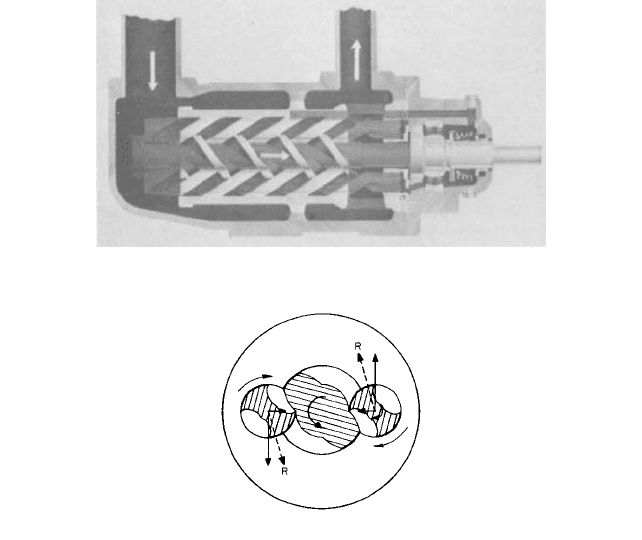
3.108 CHAPTER THREE
FIGURE 14 Single-end design. (Roper).
FIGURE 15 Force diagram on rotor set.
that generate a hydrodynamic film.The key parameters of rotor size, clearance, surface fin-
ish, speed, fluid viscosity, and bearing pressure are related as in a journal bearing. Because,
in this design, the screws transmit the driving torque to the idlers and because the casing
bores support the rotors, the pumped fluid must have some lubricating properties. This pre-
vents this pump design from being used in applications with any solids or abrasives in the
pumpage.
Since the idler rotors are supported by the bores along their entire length, no signifi-
cant bending loads are applied to them. The central driven rotor is also not subjected to
any significant bending loads because of the symmetrical positioning of the idler rotors
and the use of two threads on all the rotors (see Figure 15).This is quite different from the
two-rotor design common to the timed type where the hydraulic forces generated in the
pump create bending loads on the intermeshing pairs of screws.
In contrast to timed pumps, the untimed design, with its absence of timing gears and
bearings, appears very simple, but its success depends entirely upon the accuracy and fin-
ish of the rotor threads and rotor housing bores. Special techniques and machine tools
have been developed to manufacture these parts. The combination of design simplicity and
manufacturing techniques has enabled this design to be used for very long rotor lengths,
with a multiplicity of sealing closures, for applications up to 5,000 lb/in
2
(350 bar).
In special applications handling highly aerated oils, a four-rotor design is sometimes
employed in the untimed type. Three idler rotors are equally spaced radially at 120°
around the driven rotor. This design is not truly a positive displacement pump, and it falls
outside the scope of this section.
The rotors in untimed pumps are generally made of gray or ductile iron or carbon steel.
The thread surfaces are often hardened for high pressure and abrasive resistance. Flame
hardening, induction hardening, and nitriding are currently used. Through-hardened tool
steel or stainless steel can be used in some critical applications.
3.7 SCREW PUMPS 3.109
Rotor housings, or liners, are made of gray pearlitic iron, bronze, or aluminum alloy. In
many instances, the bores as well as the rotors can be treated by the application of dry
lubricant or toughening coatings. The pump casings are made of gray iron or ductile iron
or cast steel where shock or other safety requirements demand it.
In many untimed designs, an antifriction bearing is employed on the shaft end of the
driven rotor (refer to Figure 9) to provide precise shaft positioning for mechanical seal and
coupling alignment. This bearing can be either an external grease-sealed bearing or an
internal type with the pumped fluid providing the lubrication. The bearing also supports
overhung loads with belt or gear drives.
Seals As with any rotary pump, the sealing arrangement for the shafts is important and
is often critical. Every type of rotary seal has been used in screw pumps at one time or
another. Except for canned or sealless arrangements, all types of pumps require at least
one rotary seal on the drive shaft. The timed screw pumps with external timing and bear-
ings require additional seals at each rotor end to separate the pumped fluid from the lubri-
cating oil necessary for the gears and bearings.
For drive shafts, rotary mechanical seals as well as stuffing boxes or packings are used,
depending on the manufacturer and/or customer preference. Double back-to-back ar-
rangements or tandem mounted seals with a flushing liquid are sometimes used for very
viscous or corrosive substances.
Many different sealing face materials such as carbon, bronze, cast iron, Ni-resist, car-
bides, or ceramics are used, along with different secondary elastomer seals of various
materials chosen to suit the application. Balanced and non-balanced seals can also be used
to handle significant pressures. In some pump designs, the seals are subjected to only the
suction pressure, while in other designs the seals must seal against the full discharge
pressure. In spite of these advantages, the stuffing box is still preferred by some users.The
stuffing box requires regular maintenance and tightening, which many users find objec-
tionable, but a mechanical seal failure usually results in a major shutdown.
PERFORMANCE _____________________________________________________
Performance considerations of screw pumps are closely related to applications, and so any
discussion must cover both. In the application of screw pumps, certain basic factors must
be considered to ensure a successful installation. These are fundamentally the same
regardless of the liquids to be handled or the pumping conditions.
In most cases, the pump selection for a specific application is not difficult if all the oper-
ating parameters are known. It is often quite difficult, however, to obtain this information,
particularly inlet conditions and fluid viscosity. It is a common feeling that, inasmuch as
the screw pump is a positive displacement device, these items are unimportant.
In any screw pump application
—
regardless of design
—
suction lift, viscosity, and speed
are inseparable. The speed of operation is dependent upon viscosity and suction lift. If a
true picture of these latter two items can be obtained, the problem of making a proper
pump selection becomes simpler and the selection will result in a more efficient unit.
Inlet Conditions The key to obtaining good performance from a screw pump, as with
all other positive displacement pumps, lies in a complete understanding and control of
inlet conditions and the closely related parameters of speed and viscosity. To ensure quiet,
efficient operation, it is necessary to completely fill the moving cavities between the rotor
threads with liquid as they open to the inlet, and this becomes more difficult as the vis-
cosity, speed, or suction lift increases. It can be said that, if the liquid can be properly intro-
duced into the rotor elements, the pump will perform satisfactorily.
It must be remembered that a pump does not pull or lift liquid into itself. Some exter-
nal force must be present to push the liquid into the rotor threads initially. Normally,
atmospheric pressure is the only force present, but in some applications a positive inlet
pressure is available.
Naturally, the more viscous the liquid, the greater the resistance to the flow, and there-
fore the slower the rate of filling the moving cavities of the threads in the inlet. Conversely,

3.110 CHAPTER THREE
TABLE 1 Internal axial velocity limits
Liquid Viscosity, SSU Velocity, ft/s (m/s)
Diesel oil 32 30 (9)
Lubricating oil 1,000 12 (3.7)
6 fuel oil 7,000 7 (2.1)
Cellulose 60,000 (0.15)
1
2
low-viscosity liquids flow more readily and will quickly fill the rotor cavities. It is obvious
that if the rotor elements are moving too fast, the filling will be incomplete and a reduc-
tion in output will result. To obtain complete filling, the rate of liquid flow into the pump-
ing elements should always be greater than the rate of cavity travel. Table 1 lists examples
of safe internal axial velocity limits found from experience by one screw pump manufac-
turer for various liquids and pumping viscosities with only atmospheric pressure available
at the pump inlet.
It is quite apparent from Table 1 that the pump speed must be selected to satisfy the
viscosity of the liquid being pumped. The internal axial velocity is directly related to the
pump speed of rotation and to the screw thread lead. The lead is the advancement made
along one thread during a complete revolution of the driven rotor, as measured along the
axis. In other words, it is the distance traveled by the moving cavity in one complete rev-
olution of the driven rotor. This is also referred to as pitch on single start screws.
Fluids and Vapor Pressure In many cases, screw pumps handle a mixture of liquids
and gases, and therefore the general term fluid is more descriptive. Most of these fluids,
especially petroleum products because of their complex nature, contain certain amounts
of entrained and dissolved air or some other gas, which is released as a vapor when the
fluid is subject to reduced pressures. If the pressure drop required to overcome entrance
losses is sufficient to reduce the static pressure significantly, vapors are released in the
rotor cavities and cavitation results.
Vapor pressure is an important fluid property, which must always be recognized and
considered. This is particularly true of volatile petroleum products such as gasoline. Crude
oil is an example of a volatile fluid where the vapor pressure has been overlooked in the
past when applying screw pumps. The vapor pressure of a liquid is the absolute pressure
at which the liquid will change to a vapor at a given temperature. A common example is
that the vapor pressure of water at 212°F (100°C) is 14.7 lb/in
2
(1 bar). For petroleum prod-
ucts, as will be discussed in Subsection 9.19.1, the true vapor pressure (TVP) at any tem-
perature is a function of the Reid vapor pressure (absolute) (RVP). RVP is determined by
the ASTM Standard D-323 procedure and is quoted at 100°F (38°C). TVP at this temper-
ature is slightly higher than the RVP.
In all screw pump applications, the absolute static pressure must never be allowed to
drop below the vapor pressure of the fluid. This will prevent vaporization or cavitation.
Cavitation, as mentioned previously, results when fluid vaporizes in the pump inlet
because of incomplete filling of the pump elements and a reduction of pressure. Under
these conditions, vapor bubbles, or voids, pass through the pump and collapse as each mov-
ing cavity moves into a domain of higher pressure.The result is noisy vibrations, the sever-
ity depending on the extent of vaporization or the incomplete filling and the magnitude of
the discharge pressure. Also, an attendant reduction in output occurs. It is therefore
important to be fully aware of the characteristics of entrained and dissolved air as well as
of the vapor pressure of the fluid to be handled. This is particularly true when a suction
lift exists.
Net Positive Suction Head The suction conditions of screw pumps are normally
defined by the Net Positive Suction Head (NPSH) available at the pump inlet. In some
cases with systems open to the atmosphere, the inlet conditions can also be defined as suc-
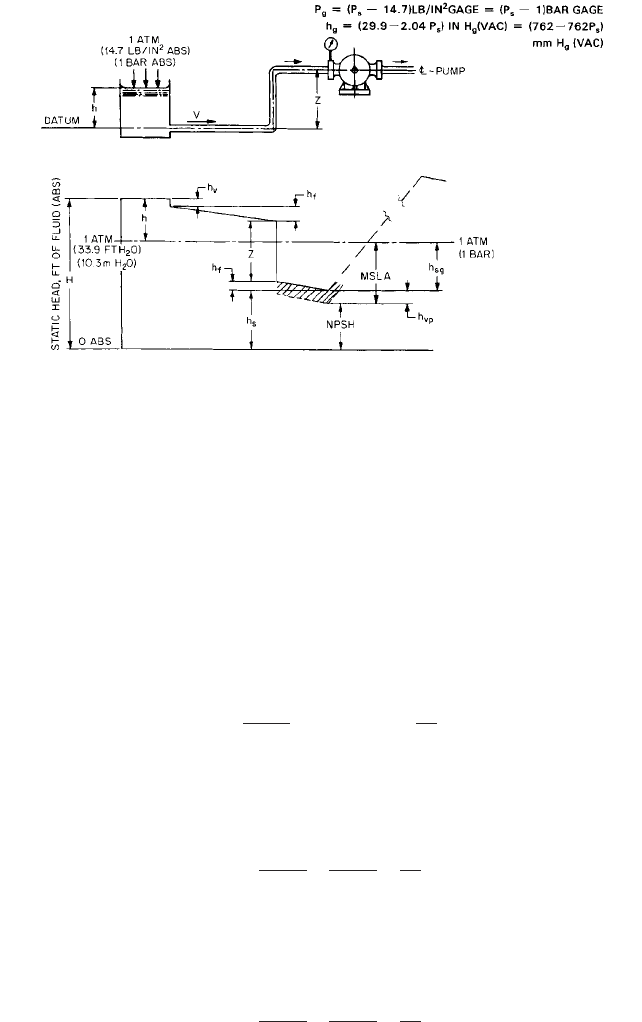
3.7 SCREW PUMPS 3.111
FIGURE 16 Relationship of hydraulic gradient, NPSH, and MSLA.
tion lift. Suction lift occurs when the total available pressure at the pump inlet is below
the atmospheric pressure and is normally the result of a change in elevation and pipe fric-
tion. Since atmospheric pressure at sea level corresponds to 14.7 lb/in
2
(1 bar) absolute,
or 30 in Hg (762 mm Hg), in a system with the suction open to the atmosphere, this is the
maximum amount of pressure available for moving the fluid, and suction lift cannot
exceed these figures. In practice, the available pressure is lower because some of it is used
up in overcoming friction in the inlet lines, valves, and fittings. It is considered the best
practice to keep the suction lift as low as possible to ensure that an adequate NPSH is
available to fill the suction cavities of the pumping screw. In all cases, the system NPSHA
(available) should be greater than the pump NPSHR (required). Figure 16 provides an
example of NPSH with the following values:
NPSHA ATM reservoir liquid level elevation head frictional head loss
velocity head, where ATM is the atmospheric pressure expressed in the height of a column
of the liquid being pumped.
where:
If the pressure at the inlet of the pump (P
g
) is known, the NPSHA is calculated as
where:
If the suction pressure is a vacuum or negative gage reading, the NPSHA is calculated as
NPSHA
C
1
h
b
sp. gr.
C
3
h
g
sp. gr.
V
2
2g
h
vp
C
2
e
2.31
10.20
for USCS units
for SI units
NPSHA
C
1
h
b
sp. gr.
C
2
P
g
sp. gr.
V
2
2g
h
vp
C
1
e
33.9>29.92
10.3>760
1.133 for USCS units
0.136 for SI units
NPSHA
C
1
h
b
sp. gr.
h Z h
f
V
2
2g
h
vp

3.112 CHAPTER THREE
where:
The maximum suction lift available is calculated as
The definitions are as follows:
V velocity, ft/s (m/s)
P
g
,h
g
pressure gage readings at the pump inlet flange lb/in
2
(bar) gage and in Hg
(mm Hg) (vac)
P
s
absolute static pressure at pump inlet, lb/in
2
(bar) abs
h
g
,h
sg
static head at pump inlet, ft (m) of liquid abs or gage
Z elevation head, ft (m) in reference to datum
h reservoir liquid level, ft (m) in reference to datum
h
b
barometric pressure, in Hg (mm Hg) absolute
h
v
,h
f
velocity head and friction head loss, ft (m)
P
vp
,h
vp
liquid vapor pressure, lb/in
2
(bar) abs
P
sv
net positive inlet pressure, lb/in
2
(bar) abs
NPSH net positive suction head, ft (m) of liquid abs
P
f
frictional pressure loss, lb/in
2
(bar)
MSLA maximum suction lift available from pump, ft (m) of pumped liquid in the
above equation
—
or in Hg (mm Hg) (vac)
sp. gr. specific gravity of pumped liquid
The majority of screw pumps operate with suction lifts of approximately 5 to 15 in Hg
(127 to 381 mm Hg). Lifts corresponding to 24 to 25 in Hg (610 to 635 mm Hg) are not
uncommon, and installations can operate satisfactorily when the absolute suction pres-
sure is much lower. In the latter cases, however, the pumps usually take the fluid from
tanks under a vacuum, and no entrained or dissolved air or gases are present. Great care
must be taken when selecting pumps for these applications since the inlet losses can eas-
ily exceed the net suction head available for moving the fluid into the pumping elements.
The defining of suction requirements by the user and the stating of pump suction capa-
bilities by the manufacturer have always been complex problems. In many cases, the
NPSHA is difficult to predict due to changes in the fluid characteristics and the operating
conditions. In addition, the NPSH required by the pump is a function of many variables,
such as pump design, fluid characteristics, and operating conditions. If the operating con-
ditions can be accurately defined, the pump manufacturers can predict the NPSHR and in
many cases can provide pump modifications that can minimize the NPSHR.
To enable the pump manufacturer to offer the most economical selection and also
assure a quiet installation, accurate suction conditions should be clearly stated. Specify-
ing a lower NPSHA than actually exists may result in selection of a pump that operates
at a lower speed than necessary. This means not only a larger and more expensive pump,
but also a costlier driver. If the NPSHA is lower that stated, the outcome could be a noisy
pump installation.
Many known instances of successful installations exist where screw pumps were prop-
erly selected for low NPSHA conditions. Unfortunately, many other installations with
equally low NPSHAs exist, which are not so satisfactory. This is because proper consider-
ation was not given at the time the pump was specified and selected to the actual suction
conditions at the pump inlet. Frequently, suction conditions are given as “flooded” simply
because the source feeding the pump is above the inlet. In many cases, no consideration is
given to outlet losses from the tank or to pipe friction in the inlet lines, and these can be
exceptionally high in the case of viscous liquids.
MSLA
C
1
h
b
sp. gr.
NPSH
C
2
e
1.133
0.01360
for USCS units
for SI units
3.7 SCREW PUMPS 3.113
When it is desired to pump extremely viscous products, care should be taken to use the
largest feasible size of suction piping to eliminate all unnecessary fittings and valves, and
to place the pump as close as possible to the source of the supply. In addition, it may be
necessary to supply the liquid to the pump under some pressure, which can be supplied by
elevation, air pressure, or mechanical means. These actions will provide the maximum
NPSH possible to the pump inlet.
Entrained and Dissolved Air As mentioned previously, a factor that must be given care-
ful consideration is the possibility of entrained air or other gases in the liquid to be pumped.
This is particularly true of installations where recirculation occurs and the fluid is exposed
to air through either mechanical agitation, leaks, or improperly located drain lines.
Most liquids will dissolve air or other gases retaining them in the solution, the amount
being dependent upon the liquid itself and the pressure to which it is subjected. It is
known, for instance, that lubricating oils at atmospheric temperatures and pressures will
dissolve up to 10 percent air by volume and that gasoline will dissolve up to 20 percent.
When pressures below the atmosphere exist at the pump inlet, dissolved air will come out
of the solution. Both this and the entrained air will expand in proportion to the existing
partial pressure of the air (= absolute pressure minus the vapor pressure of the liquid).
This expanded air will accordingly take up a proportionate part of the available volume of
the moving cavities, with a consequent reduction in delivered flow rate.
One of the apparent effects of handling liquids containing entrained or dissolved gas is
noisy pump operation. When such a condition occurs, it is usually dismissed as cavitation.
Then too, many operators never expect anything but noisy operation from rotary pumps.
This should not be the case, particularly with screw pumps. With properly designed sys-
tems and pumps, quiet, vibration-free operation can be produced and should be expected.
Noisy operation is inefficient; steps should be taken to make corrections until the objec-
tionable conditions are overcome. Correct system inlet designs and optimized pump
designs with a proper speed selection can go a long way toward overcoming the problem.
In some applications, the amount of gas can be significant and can make up the major-
ity of the fluid volume. See the later subsection on handling special multiphase applications.
Viscosity It is not often that a screw pump is called upon to handle liquids at a constant
viscosity. Normally, because of temperature variations, a wide range of viscosities will be
encountered. For example, a pump may be required to handle a viscosity range from 150
to 20,000 SSU, the higher viscosity usually resulting from cold-starting conditions. This is
a perfectly satisfactory range for a screw pump, but a better and a more economical selec-
tion may be possible if additional information can be obtained. This information includes
such things as the amount of time the pump is required to operate at the higher viscosity,
whether the motor can be overloaded temporarily, whether a multi-speed motor can be
used, and if the discharge pressure will be reduced during the period of high viscosity.
Quite often, only the type of liquid is specified, not its viscosity, and assumptions must
be made for the operating range. For instance, Bunker C or No. 6 fuel oil is known to have
a wide range of viscosity values and usually must be handled over a considerable temper-
ature range. The normal procedure in a case of this type is to assume an operating viscos-
ity range of 20 to 700 SSF. The maximum viscosity, however, might easily exceed the
higher value if extra-heavy oil is used or if exceptionally low temperatures are encoun-
tered. If either should occur, the result may be improper filling of the pumping elements,
noisy operation, vibration, and overloading of the motor.
Although it is the maximum viscosity and the expected NPSHA that are used to deter-
mine the size of the pump and to set the speed, it is the minimum viscosity that affects the
capacity. Screw pumps must always be selected to give the specified capacity when handling
the expected minimum viscosity since this is the point at which the maximum slip, and hence
minimum flow rate, occurs (see Figure 17). It should also be noted that the minimum vis-
cosity often determines the selection of the pump model because most manufacturers have
special lower-pressure ratings for handling liquids having a viscosity of less than 100 SSU.
Non-Newtonian Liquids The viscosity of most liquids is unaffected by any agitation or
shear to which they may be subjected as long as the temperature remains constant.These
